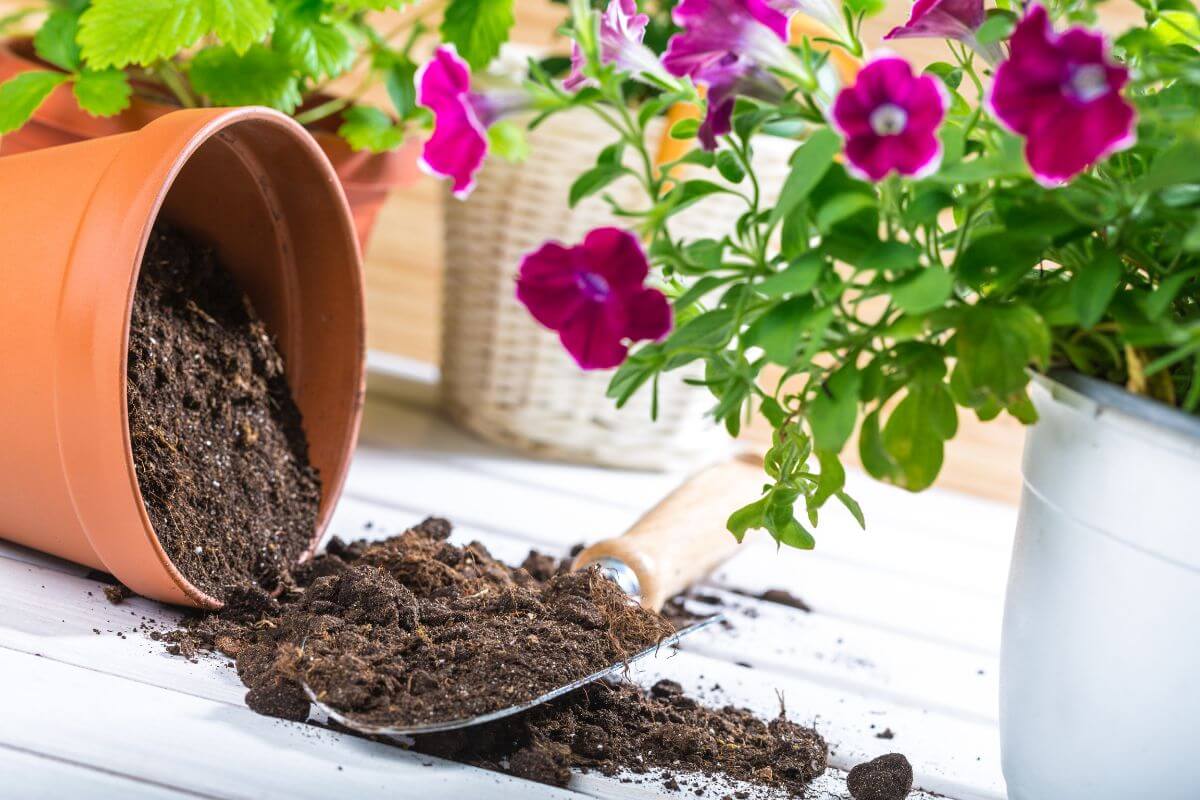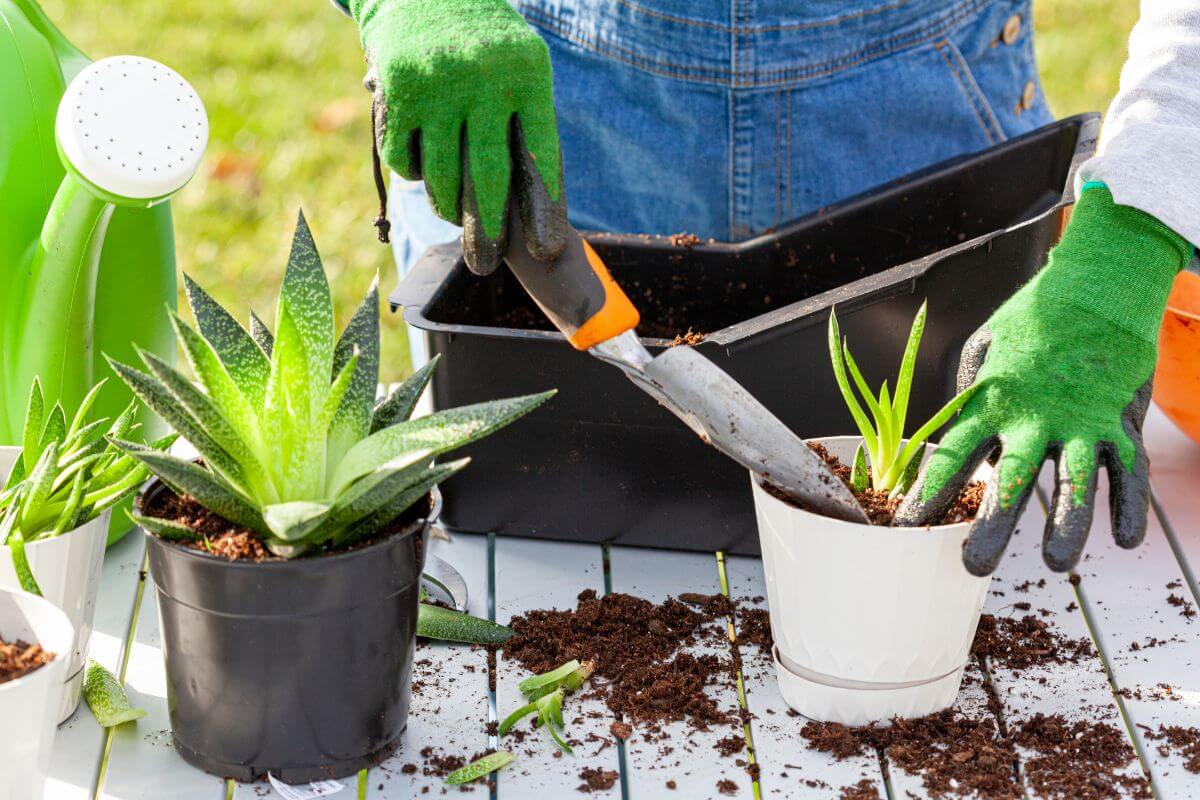If you’re new to gardening, and even if you’ve got few years under your belt, the sheer number of different kinds of soil on the market can be overwhelming.
In this article, I’m going to go into a bit more detail about potting soil, what it is composed of, and what you should use it for.
I’m also going to highlight the difference between potting soil and potting mix.
You may think that potting soil and potting mix are just two different labels for the same thing, but they are actually two separate products designed for specific uses.
- Related: Not all soil is the same
What is Potting Soil?

Potting soil is a type of soil that is specifically for potted plants. These can be indoor or outdoor plants, but potted plants generally have different needs than plants that are planted directly in the ground.
The most obvious example is the space for plant roots. Potted plants can’t send roots deep into the earth to find water, and so they have to be watered more regularly.
Potted plants can also have issues with waterlogging. That occurs when roots sit in excess water if the soil drainage is poor, or you have them standing in a pot without drainage holes.
The soil should be able to retain moisture to keep in water and nutrients, as well as drain easily to avoid root rot.
Potting soil should be light and fluffy to accommodate root growth. As potted plants are usually displayed on stands or shelves, excess weight can be an issue, so materials are added to try and make the mix lighter than pure soil or compost.
Potting soil comes in many forms, usually aimed at use by specific plants and containing nutrients that cater to their needs.
Although the actual soil nutrient content of each element varies, the usual potting soil ingredients are:
- Organic materials – Organic matter is the basis for most soils. It contains some nutrients and is good for moisture retention, as well as drainage. Suppliers usually include some lightweight, moisture-retaining materials that are low in nutrients, like peat moss and coconut coir.
- Inorganic materials – These are natural materials that do not come from living things. This includes pumice, sand, and perlite. These are added for extra moisture retention, aeration, and drainage.
- Fertilizers – As potting soil often sacrifices nutrient-rich ingredients to keep the weight down, fertilizers are usually added to compensate for nutrient deficiencies. Read more on various fertilizer types and how to use them.
For those who are organic gardening and want to steer clear of chemicals, always opt for organic potting soil or mix.
Potting Soil vs Potting Mix
These two terms are often used interchangeably, but there are major differences between the two. Below, I’ve included a simple chart to show you the variations.
| Contents | Potting Soil | Potting Mix |
| Contain Soil? | Sometimes | Never |
| Sterile? | No | Yes |
| Nutrient-Rich Matter? | Yes | No |
| Compost or Fertilizer? | Both | Only fertilizer |
| Weight | Heavy | Light |
The main difference between potting soil and potting mix is that potting mix doesn’t contain any soil. This makes it sterile and extremely lightweight, which is perfect for houseplants.
If you want to grow plants in window boxes, macrame hanging planters, roof gardens or other weight-sensitive locations, consider getting potting mix instead of potting soil.
Generally, I would use potting soil for outdoor potted plants and indoor plants in floor pots. I’d use potting mix for houseplants and some container plants that need their roots to move more freely in the potting medium.
Potting mix also eliminates the possibility of weed seeds and insects being in the mix.
Potting Mix Types

Different potting mixes are created for different types of plants. There are also mixes for different stages of growth, like seed starting.
Keep in mind that even if a potting mix is called “African Violet Potting Mix,” it can still be used for other plants that have the same need for essential nutrients.
- Cactus and Succulent Potting Mix – This is a fast draining mix. It usually contains sandy soil and natural additives to keep the mix slightly alkaline. Both cacti and succulents require a medium that drains quickly and doesn’t hold much moisture.
- African Violet Potting Mix – African violets need a slightly acidic soil with a pH balance of 6.0-6.5. This mix is specially formulated with additives such as dolomitic lime that meet these requirements.
- Orchid Potting Mix – Orchids need fast drainage and lots of air around their roots. This mix usually contains bark to allow for lots of air pockets and little moisture retention.
- Organic Potting Mix – This is any mix that contains no chemical fertilizers. It can contain organic ingredients like bloodmeal, bone meal, kelp meal, and alfalfa meal.
- Moisture-Control Potting Mix – These potting mixes contain moisture retaining elements such as sphagnum moss, coco coir, and non-toxic wetting agents.
As you can see, different plants can have drastically different needs. For this reason, you should always opt for a potting soil or mix that suits your needs for healthy plant growth.
For a list of suggestions, check out the Best Potting Soil for Indoor Plants article.
Potting Soil vs Topsoil
| Contents | Potting Soil | Topsoil |
| Contain Soil? | Sometimes | Yes |
| Sterile? | No | No |
| Nutrient-Rich Matter? | Yes | No |
| Compost or Fertilizer? | Both | Neither |
| Weight | Heavy | Very heavy |
Topsoil is soil that is harvested from the top layer of earth. It varies in quality, and can contain large stones and contaminants.
Topsoil is most commonly used for landscaping, filling in holes, and adding soil to places where there was no natural soil originally.
Using it for potted plants is not recommended as it is usually low quality, compacts easily, and will not give plant roots sufficient room or air.
Potting Soil vs Garden Soil
| Contents | Potting Soil | Garden Soil |
| Contain Soil? | Sometimes | Yes |
| Sterile? | No | No |
| Nutrient-Rich Matter? | Yes | Yes |
| Compost or Fertilizer? | Both | Can contain either |
| Weight | Heavy | Very heavy |
Garden soil is treated and refined topsoil. It may have fertilizers and nutrients added to it, and you can get plant-specific garden soil.
Garden soil is what you would usually use when starting a vegetable garden or flower bed outdoors.
On the surface, it seems that potting soil and gardening soil could be interchangeable. But in actuality, the weight of garden soil makes it unsuitable for use in indoor gardening.
You can create your own potting soil using garden soil as a base. Add compost and lightweight materials like clay pellets, peat moss, and coir to add aeration and combat the soil becoming too compacted.
Potting Soil Mix Final Thoughts
If you want to grow plants in pots, potting mix is usually the type of soil to choose for indoor plants.
If you are creating your own potting mix, remember to keep the weight low, give it adequate aeration, drainage, and moisture retention.
Potting Soil Mix FAQs
Can I use potting mix instead of soil?
The answer depends on whether you’re growing houseplants indoors or outdoor plants outside. If you’re growing indoor plants, then yes! You can use potting mix instead. However, if you’re growing outdoor plants, then it’s better to use garden soil.
What soil is best for potted plants?
The best soil for potted plants is one with high nutrient content. A good option is a combination of equal parts sand, loam, and perlite. Another great choice is a mixture of half loamy soil and half sand. There are various potting soils and mixes that you can purchase online.
Where to buy potting mix?
You can buy potting mix at your local garden centers. If you don’t want to carry the heavy bags yourself, you can have them delivered. You can also choose to buy them online as they’re readily available on sites like Amazon.com. They can be cheaper online sometimes.
When to use potting mix?
There are various ways to use potting mix. Use potting mix whenever you want to start seeds inside. Use it for seedlings once they’ve sprouted. And finally, use it for established plants after transplanting them into larger containers.
Can I put potting soil in a garden bed?
Yes, you can put potting soil in a garden bed, but only if you know how to do so properly. First off, make sure that you remove all weeds from around the area before planting anything. Then dig out an appropriate sized hole and fill it up with potting mix. After this, water thoroughly and wait until everything has settled down. This should take about two weeks. Once done, you can now put any kind of soil back into the same spot.
Do you need to add fertilizer to potting soil?
No, adding fertilizer to potting soil isn’t necessary unless you’re growing plants that have certain nutrient needs. Fertilizer will help increase growth rates and overall health of those plants.


